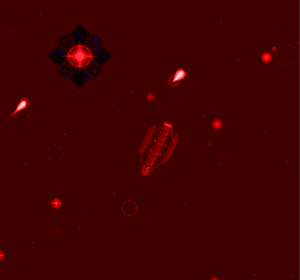HyperSpace
|
Warning: This page contains speculation as fact, fan fiction, and/or other dubious text. Please edit and improve this page. |
HyperSpace is a "higher dimension" or set of dimensions that forms an alternate space-time adjacent to TrueSpace. Modern technology has allowed spacefaring civilizations to use HyperSpace as a medium for communication (Hyperwave) and transport (Hyperdrive). HyperSpace (literally meaning "above space" in English) was the first non-TrueSpace dimension to be discovered, and after the work of the Androsynth and the discovery of QuasiSpace by the Alliance is now known to be only one of many such dimensions.
Physics
The most striking feature of HyperSpace is the different properties electromagnetic radiation has within it; HyperSpace's different physical constants cause the speed of light to be much greater than the speed of light in TrueSpace. Observers in HyperSpace thus perceive electromagnetic radiation as "red-shifted", as the increased speed of propagation of light waves causes their wavelengths to become longer. Beyond this oddity, the physical laws in HyperSpace are similar enough to those in TrueSpace to allow vessels and their passengers safe passage. However, some humans entering HyperSpace have encountered intense feelings of disorientation and discomfort, effects of HyperSpace's unique attributes.
While most of HyperSpace is cast in a blood red light, there are some regions that don't appear red. The majority of these regions are strong TrueSpace gravity wells, which under certain conditions create transdimensional vortices into HyperSpace. These vortices are regions of overlap with TrueSpace, creating natural exit points from HyperSpace to TrueSpace. There is also a constant display of bright explosions and bursts of light in HyperSpace. Though the nature of these energetic (but harmless) events is unknown, they are theorized to be manifestations of objects moving quickly through HyperSpace into adjacent dimensions.1 Similar events have been observed in QuasiSpace.
Travel
Hyperdrive ships operate by generating hyperdrive warp fields, allowing ships to "push up" or "translate" into HyperSpace. This may be similar to the focused dimensional fatigue beams used to access QuasiSpace. The independent development of Hyperdrive technology has been a near universal among modern civilizations, the notable exception being the Arilou who also make use of QuasiSpace. This technology is usually accompanied by HyperWave, a process that involves transmitting information at seemingly superluminal speed via HyperSpace. Even vessels originally designed for subluminal speeds, when equipped with Hyperdrive, can be practically used for short-distance HyperSpace travel as evidenced by the Syreen migration from Syra and the Androsynth exodus from Earth.
While a Hyperdrive field allows TrueSpace vessels to travel through HyperSpace, the slightly different laws of physics within HyperSpace however impose a constant drag force on a vessel, forcing Hyperdrive ships to constantly thrust and expend fuel in order to make headway. Similar to TrueSpace gravity wells, a ship contained in Hyperdrive fields creates a shadow, or "spoor," in HyperSpace that indicates its presence visually but also masks the identity of the ship. When the Hyperdrive fields of different ships collide, the fields interfere with each other, causing them to dissipate and return their contents to TrueSpace. Any interaction with a Hyperdrive field and a natural gravitational intrusion into Hyperspace has the same effect; thus, large local gravity sources prevent the formation of stable Hyperdrive fields (hence the impossibility of "pushing up" within a star system). 3289848634
Astrometry
The distance between any two stars in HyperSpace tends to be astoundingly shorter than in TrueSpace; the apparent travel time of voyages of thousands of light-years in TrueSpace is reduced to a matter of weeks from the reference frame of a HyperSpatial traveler. However, the correspondence between points in HyperSpace and TrueSpace may not be one-to-one and certainly does not preserve the geometric orientation of their TrueSpace relationships. Not all stars generate TrueSpace intrusions into HyperSpace, and, although all local HyperSpace gravity wells are clustered in a single galaxy that appears to be an analogue of the local TrueSpace galaxy (called the Milky Way Galaxy by Humans), the spatial relationship between the Hyperspatial locations of stars is often greatly distorted from their TrueSpace locations. Additionally when two hostile vessels encounter and force re-entry into TrueSpace, the ensuing combat invariably takes place near some rogue planetary body. This may be because HyperSpace closely clusters about gravitational sources in TrueSpace, such that all points in HyperSpace correspond to some point near a TrueSpace gravitational source.
In mapping HyperSpace, Chenjesu astronomers have divided stars located in HyperSpace into groups or constellations, which Humans have freely named after notable stars and constellations from TrueSpace astronomy, even though most of these stars (whose TrueSpace labels are mostly just numbers) bear no relation to the TrueSpace stars for which they are named. This is rarely a problem, since the advent of HyperSpatial travel in Human civilization has reduced TrueSpace astronomy to primarily an academic concern (as no TrueSpace-based method of communication across the stars is commonly used or even possible). The Chenjesu standard coordinate system contains a certain set of constellations that have been well-mapped and explored by their scientists; this map defines the safely traversable bounds of "known space" for most races. No races native to this region have had the resources to extend the boundaries of Chenjesu maps very far; only such races as the Ur-Quan or Melnorme are known to have extensively traveled and explored the galaxy outside the Chenjesu starmap.
See also
Notes and references
- 1Star Control II Manual, pp. 34
